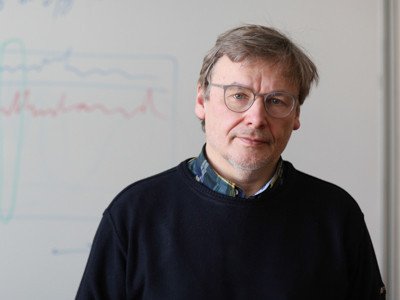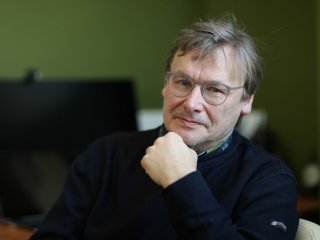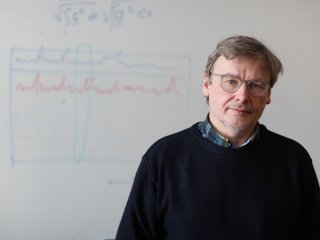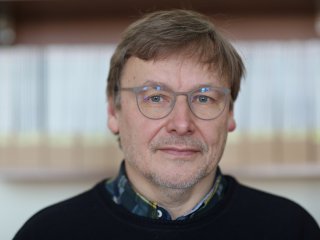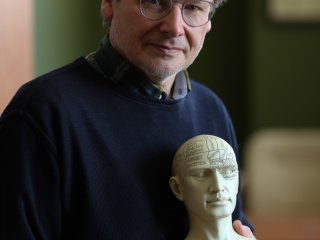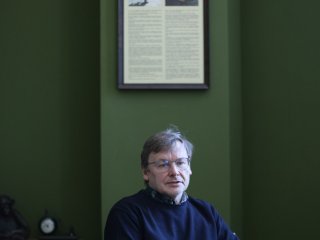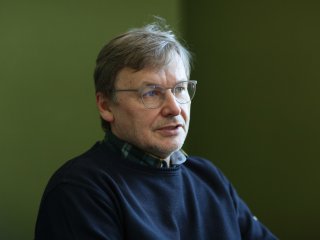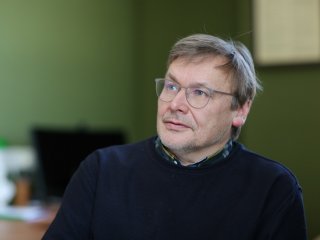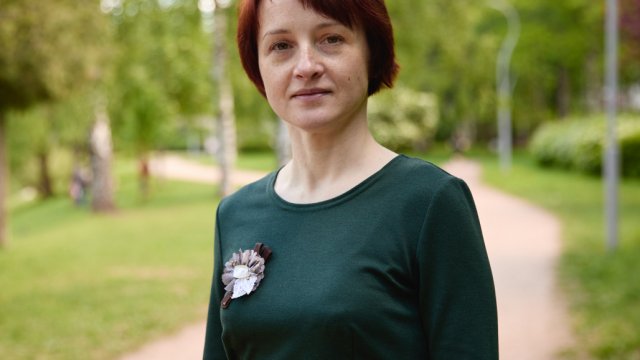I know myself as a thought, but I
certainly do not know myself as a brain.
René Descartes
The 21st century has every chance of going down in history for breakthrough discoveries in human brain research. Scientists hope that brain science will soon be able to lift the veil over the nature of the intellect and consciousness.
Konstantin Vladimirovich Anokhin, Director of the Institute for Advanced Brain Research, Lomonosov Moscow State University, Academician of the Russian Academy of Sciences, believes that this would require a basic theory of the brain that would answer three main questions: What is the design of the self? How is it formed? How does it work? Only then we would understand who we are, where we came from and where we are going.
Konstantin Vladimirovich, what makes our brains think?
The fact that we ourselves are concentrated in our brains. This is the short answer. The long answer is in the hypernetwork brain theory that is focused on the brain essence, on what makes it different from other organs of the human body.
Please note that to avoid a banal short answer to your question, I didn’t say that our brains were ourselves. Instead, I said we were concentrated in our brains. How can “we” and “in our brain” exist at the same time? This seems to be an obvious paradox. However, when we talk about birth or death of a person, we do mean the entire body. But if brain transplantation surgery was to become available, we would be thinking of our transition to a new body along with our brains. Understanding this position of scientific facts that would make these circumstances non-paradoxical, is the first step towards solving the great mystery of the brain.
This secret has been attracting the students of human nature for centuries. Once, an acquaintance of the famous French philosopher and mathematician René Descartes asked him which books on physics the latter preferred. In response, Descartes took him to an annex to his house, where there were bodies of animals he had performed autopsies on, lying on tables, and said, “These are my best books.” Descartes was trying to find out where and how the soul makes contact with the brain. His published works covered some of the hypotheses and mechanisms. But Descartes had a secret notebook where he recorded his most secret ideas using a secret code. 16 years after his death, a young diplomat from Hannover knocked on the door of an old friend of Descartes’s, begging to see the secret records. The young man was the future great German philosopher and mathematician Gottfried Leibniz. He was longing to find the answer to the same question that Descartes had worked on. Very reluctantly, the executor of Descartes’s will allowed Leibniz to take a brief look at the secret notebook, and Leibniz only managed to copy one and a half pages. Descartes’s secret notebook soon disappeared forever, and the 1.5 pages copied by Leibniz are all we know about it. One of the pages showed Descartes’s drawing of a brain, outlining some of its structures and using bold lines to highlight the hypothalamus.
Later, Leibniz developed his own theory of the relationship between the soul and the body, whereby the world is built with extradimensional beings — monads, which, according to him, should be seen as something like souls. His arguments involved, amongst other things, the famous Leibniz mill — the argument against mechanical materialism, i.e., against the idea that our thoughts result from interactions between parts of the brain working as gears of a complex machine. However, another great philosopher, the Scotsman David Hume soon confidently described thinking as week fluctuations of the brain.
The philosophical quest for the intellect-brain relationship continues to this day. But the main distinction of our time is that there is a new brain science now, trying to deal with this problem. Why today and why a new science? The thing is that the thinking brain was not transparent for neuroscientific research for a long time. Science lacked reliable methods to “see” how millions of nerve cells interact with each other during the course of mental activity. The most important secrets of the brain are recorded in the language of communication such teams of individual neurons use. Today, methods of studying this language are starting to become available to neuroscientists. We already can study a live wakeful brain of an animal or, sometimes, even a human, and see how thousands of its neurons form communities that generate thoughts, feelings and behaviors. I’m convinced that the time for solving the deepest secrets of the brain has come. After the great discoveries in geography, physics, chemistry, and biology, now is the time to find out how our brain cells produce our “selves.”
Of course, we can’t be absolutely sure that the knowledge and methods we have today are sufficient. But, as one remarkable physicist said, the only way to know how high we can fly is to keep rising till the Sun melts the wax on our wings. Personally, I would bet that this century will be remembered as the time when the basic nature of intellect and consciousness was discovered. But to make this happen, our concepts of the very essence of the brain have to change. This is what the hypernetwork brain theory is trying to do.
What is the theory all about?
It allows us to understand the brain on an entirely new level. For centuries, the brain has been viewed as one of the organs of the human body — along with the heart, the liver, and the kidneys. Even today, neuroscience describes the brain just as a complex cellular network that consists of myriads of neuronal and glial elements. The hypernetwork brain theory says that this view is fundamentally wrong. According to the theory, the true nature of the brain can only be understood using the principle of maximum existence. According to this principle, the essence of any object is determined by its maximum causal power — the highest ability to interact with other objects in the world, be impacted by and impact the world as a whole. As Plato explained through the Eleatic Stranger in one of his famous dialogs in the Sophist, the nature of being is in the ability to impact and be impacted; being is nothing other than this ability, this power. According to the hypernetwork brain theory, the maximum causal power of the brain does not depend on its physiological capacities, as is the case with all other organs of the body, but on an active relationship of its host, the entire body, with the complex material world — first with the surrounding world and then with the inner world, which develops on the basis of such interactions. In other words, the theory says that a brain on the top level of its causal power potential is an intellect, i.e., what Descartes called res cogitans — a thinking substance.
This is the fundamental point of the theory, its central identity. But if the idea boils down to this alone, what we get is the well-known intellect/brain identity theory, which has had a lot of versions over history. Young I. M. Sechenov wrote about it in his essay The Attempt to Reduce the Mechanism of Mental Phenomena to Physiology, better known as Reflexes of the Brain — a book that I. P. Pavlov called “a stroke of genius in the Russian scientific thought.” I. P. Pavlov himself dreamt about “the natural and inevitable convergence and, eventually, merging of the psychological with the physiological, the subjective with the objective.” In the western analytical philosophy of the second half of the last century, this solution spread as scientific materialism or the theory of identity. Dozens of prominent scientists and philosophers adhered to this viewpoint.
What all such solutions had in common was the fact that they identified intellect with the traditional anatomy of the brain — the neural network, and the mind – with the physiological processes in the neural network. In other words, they consigned the mind to the design and performance of a physiological organ.
According to the hypernetwork brain theory, the error of those views was not the idea of identity but what intellect was identified with. The essence of the theory is that it is introducing the idea of a special essential design of the brain — the neural hypernetwork. According to the theory, the maximum causal power of the brain — the mind — is in this particular structure. The theory describes the design of this neural structure, and the principles of its generation and functioning.
The neural hypernetwork contains everything that we are; all the atoms of our “selves,” our personalities, our conceptions, knowledge, and memories, organized in a network. Every element of the network, which the theory calls COGs (COgnitive Groups), is coded in the brain by a distributed network of neurons. The groups share some of their neurons, thus creating connections between the groups. The theory calls those linking components of cognitive groups LIGs (LInkers of Groups). Together, COGs and LIGs form a network of multiple neural networks — a neural hypernetwork. The theory calls this cognitive hypernetwork a “cognitome.”
It should be underlined that, although materially the cognitome elements, nodes and links in the hypernetwork are groups of nerve cells, they cannot be equalized with the nerve cell groups in terms of their properties, i.e., their causal potential, the same way as proteins cannot be equalized with the amino acid they consist of in terms of their properties. Nodes in a neural hypernetwork possess fundamentally new properties; they are granules of cognitive information – our knowledge of the world.
Answering your original question, one could say that it is the processes occurring in such hypernetwork that make our brains think. Thinking is the traffic in the neural hypernetwork of human intellect.
The neural hypernetwork starts developing as early as in the fetal period when the nerve system forms. A baby is born with rudiments of this cognitive network, still simple but already prepared by millions of years of evolution for what the body is going to face. A baby has some knowledge already – the world is not just an uncharted area. A baby knows some entities and values: warmth, milk, and voice of its mother (which, as we know, a baby learns to recognize while still in the womb). These things make the initial core of the cognitive hypernetwork and personality.
Unlike the neural network in the brain, which generates almost no new elements after birth, the neural hypernetwork, our intellect, our “selves” grow extremely fast when we are children, and continue to grow further, in our adulthoods, for as long as we live. The ageing and deterioration processes start in the network at some point, and that constitutes the decay of personality, which is especially severe if the person suffers from neurodegenerative diseases.
The grand task set before neuroscience is to understand the structural principles of this cognitive space, its growth and processes in it. I think that the basic laws will prove to be very simple. Their simplicity may surprise us or our descendants who will know these laws, just as people were surprised at how few there were the laws of Newtonian mechanics and Darwinian natural selection.
Therefore, our brains are also our intellect, what makes our personalities unique. But understanding this requires an effective theory. The neurosurgeon and theologian V. F. Voino-Yasenetsky said once: “I have operated on the brain many times, but never saw the mind inside the skull.” As if in response, Albert Einstein said: “What we manage to observe only depends on the theory.” Only an approach armed with theory, would provide understanding of that exceedingly complex natural design forming our “selves,” our intellect, and our mind. And I’m totally convinced that now is the historical moment when such basic theory is going to be created.
Why did Nature give this particular organ such capabilities, such complex design?
Because it was the nerve system that proved to be capable of integrating information throughout the body, including that from the sensory boundaries with the environment, and elevating the information to the level of meaning of existence for the entire body. The former is the critical feature of the neural network, and the latter is the fundamental and non-reducible property of the neural hypernetwork.
Why did the neural network and its hypernetwork develop as properties of the brain? According to Jacques Monod, one of the founders of molecular biology, Nature just “turns coats,” i.e., it uses material at hand. When in very primitive organisms, cells releasing chemicals started interacting with each other, it became possible to deliver the substances to particular body parts anywhere in the system. It turned out that that instrument allowed, albeit slowly, to integrate a body consisting of a large number of elements. Doing it fast was made possible by the mechanisms that propagated impulse signals in the network, allowing its hosts to coordinate their behaviors in relation to the environment and to categorize the world in terms of their needs.
We know that various organisms evolve following independent paths, and have very different nervous systems. The nervous system of a snail is not similar to that of a fly, which is not similar to that of an octopus, which is not similar to that of a lizard, which is not similar to that of a human being. But from the viewpoint of the general principles, the graph theory, and the mathematical patterns of their designs (which is how nervous systems are viewed in brain science today), those nerve networks, despite their differences in appearance, show a unique common organization method, which is different from both random networks where everything is connected to everything else, and regular networks, where one thing connects to the next, like a grid. Elements in a nervous system are in close contact with their immediate neighbors, but some of those neurons transmit targeted signals to an entirely different part of the big network, which receives it immediately, and then the receiving part also has its own local processes. This allows the big network to live a single life, while having all the benefits of local information processing that occurs in every part of the system. Which part of the evolution drove the development of those common organization principles, the raw material being so different? The hypernetwork brain theory says that, what is hidden behind the facade of this process is cooperative groups of neurons and their interactions, which ensured cognitive adaptation of live beings to the difficult external environment.
When we read the works of, let’s say, Plato who lived in the 5th and 4th centuries B.C., we can see that, despite the lack of knowledge that modern people have, his brain was no less developed than our brains and it was probably even more developed than the brains of modern people that have an ocean of information available to them. What does this tell us?
As I said before, what we used to see as a nerve network, conceals a hypernetwork based on it. But this means that there may be two brains that would look identical, have the same weight, the same number of nerve cells and links between them, but with very different hypernetworks and their contents. Moreover, one brain could be a much greater intellect, a more developed hypernetwork, while the other one could have a weak hypernetwork. Plato's neural hypernetwork seems to have been very powerful. What is the cause of this? One of the main neural hypernetwork development tools in a human is thinking. By generating new combinations of neurons, COGs, the brain can save them as unique elements of the personality, of experience in the hypernetwork. And here comes the question: How much do you think? Bernard Shaw famously replied: “Few people think more than two or three times a year; I have made an international reputation for myself by thinking once or twice a week.”
I read that my brain is the “greediest” of my organs because it takes up quite a lot of oxygen and a great deal of other resources from the body. Some people believe that it makes decisions on its own and just informs us after the fact. Can it really be so autonomous?
There are most important questions that get us back to the very beginning: What is “self,” and how does the concept relate to my brain? I am a personality, a being, a person. No personality is smaller than a body. However, as we have seen, the personality is concentrated in the neural hypernetwork of the brain. Nevertheless, the brain has to be in a body for the hypernetwork to form and for the brain to become a brain. The body allows the brain to interact with the surrounding world, to act, to feel needs, pain, desires, passions. Take the brain out and put it into a flask that maintains its metabolism — you will not develop an intellect.
Like in A. R. Belyaev’s novel "Professor Dowell's Head"?
Professor Dowell's head contained a brain formed by hundreds of thousands, millions of episodes of growth of the cognitive hypernetwork, experienced by the infant, the child, and the youth who then became Professor Dowell. The cognitome had been created in his brain already. But if there is no hypernetwork, no blocks, buildings, streets, lanes and alleys in this “town,” there will be no traffic, no mental processes, no consciousness.
rding to the hypernetwork theory, it is wrong to say that the brain is independent and makes decisions for us. Why? Because the neural hypernetwork, the cognitome has two levels — the conscious level and the unconscious one, but both are intellect, with intellectual processes going on in them. The decisions the hypernetwork makes on the unconscious level, are also part of our intellect’s operations; the decisions are based on the entirety of our previous experience, our history, our knowledge.
What led you to the hypernetwork brain theory?
This is a not a simple question. Imagine that you keep thinking of a solution to a problem. You have thought about it some hundred thousand times over several decades. Every such act of thought is another step up on a ladder. Sometimes, it’s a step up, sometimes – a step down. A huge number of attempts where the scientist puts forward a hypothesis, critiques it himself or herself, kills it, comes up with another one and kills it as well, and this goes on for years. How do we know which of the hundred thousand steps of the ladder were critical in the end?
There was a moment when the idea of cognitive groups that I called COGs for short, came out of many years of trying to understand the brain. And a COG stands for a “COoperative Group” as well as a “COgnitive Group.” Together, its elements create a new quality. In English, the term cog also means a person or a thing that is a small but necessary part of a structure, an organization. In this sense, COGs are particles, atoms, the necessary causal elements of experience, knowledge, the mind, the cognitome.
The concept of cognitive groups is an extension of the idea of “sensory groups,” “natural groups” or “central groups of simultaneous action” created by I.M. Sechenov, a great physiologist of the 19th century. Describing the groups, he wrote, in particular: “A particular sensory group always corresponds on the outside to a simultaneous complex.” The notions of systemic cellular groups with higher properties also continue the line of the functional systems theory of the school I am part of. And the idea of LIGs, linkers of groups, cognitive links that code knowledge about interrelations of external objects, develops the theory of temporary nerve connections, created by another great Russian physiologist — I.P. Pavlov. That is, one of the answers to your question could be that the hypernetwork brain theory arose from achievements of our predecessors, great scientists.
In the brain, cognitive groups and links between them are diffused. They could be imagined as neural clouds. One cognitive element is a whole cloud of nerve cells in the brain. Another such element is also a cloud in the same brain. That is, a cloud in a cloud. And there are many thousands of such clouds, possibly millions. Those are clouds within clouds within clouds, etc. In certain subsets of their neurons, in LIGs, they overlap multiple times, therefore changes in one cloud spread to hundreds of other clouds instantly. It's this that allows you, when I say some key word activating its COG, to retrieve from your memory everything you know or remember in relation to the concept.
It wouldn’t be possible to map this whole system with anatomical coordinates and say that this cloud is located in this part of the cortex, and that one – in that part with neuron processes in-between, linking them. On the other hand, outside three-dimensional coordinates, these elements form a strictly structured space. Therefore, there was a moment when one came to understand that above the neural network that forms the basis for such clouds, there develops a special network with a different architecture and its own topology. And, as I said before, it grows, even though the size of the neural network itself does not increase. That’s how the hypernetwork idea was born. There is a three-dimensional structure of the brain on its bottom level, while at the top — there is a structure of our intellect, our mind, our “self,” which has an entirely different design, properties, and causality of the psychological level.
Having created the concept of a neural hypernetwork, I started looking if there were concepts of such structures in mathematics, and learned that there were, but not many. You would find no mention of hypernetworks in the key guidelines on the network theory. The network theory specialists I asked about hypernetworks stared at me blankly. But some groups of mathematicians had come to the concept.
One of those is developing ideas of the British theoretical physicist and mathematician Ron Atkin who, in the early 1970s, came up with the idea of there being topological structures that form on the boundaries of different of matter organization levels. His pupil, Professor Jeffrey Johnson published a monograph in 2013 on hypernetworks in complex systems. However, I have to say that other mathematicians understand very different structures as hypernetworks. This branch of mathematics does not seem quite established yet. But I hope that hypernetwork research will push mathematics to create a language to describe such structures, the way physics research once guided the progress of mathematical physics.
Science in general makes progress in this direction, and today, following the question of how the outer world works, the question on the agenda is how the inner world of a human being works, who we are and where we come from. All religions of the world give answers to these questions. But when science starts giving satisfactory answers to them, humanity will face a large-scale cognitive revolution — possibly even a greater one than the Darwinian revolution that changed our understanding of our place in Nature.
You mean that would be the answer to the question: What is consciousness, intellect and thinking?
Yes, these are the questions that the 21st century science should try and answer. Those are also the questions about the nature of the soul if you like. In the last 400 years, the western civilization largely lived under the influence of Descartes who divided the entire nature into the spatial, physical world and the spiritual world. He described the latter using two terms, mind and soul, which he used as equivalent. They were the same thing to him. The modern science is based on the assumption that there is one world and that intellect is part of it. Therefore, a scientific solution to the problem of intellect would mean an answer to the question about the nature of the soul.
Would it affect religious views? What do you think?
If your religious convictions survive the facts on the origins of the animal world and humans that biology has accumulated since Darwin, you will have no problem with your religious ideas regarding the soul as you face the data on the brain that science is accumulating.
It’s harder for the likes of me, i.e., for the people who find such contradictions. Here, I would split the question in two: the ontological part and the ethical one. In the field of ontology, our ideas of how the world works, including our inner world, the human intellect, the soul, we have to rely, increasingly, on science rather than religion, even though our scientific ideas may be shaken badly as well. As for morality, the situation is much more complicated. The experience of the last century and a half shows that the attempts to build moral principles, secular ethics based on scientific ideas were, to put it mildly, not quite successful, if not disastrous. It is most likely that the modern science still lacks a foundation reliable enough for building such moral standards, similar to the one built by religion on the basis of millennia of human community experience. In this sense, religious morality, for all its faults, will apparently remain a more reliable empirical basis for the life and behavior of people for a long time.
Soon, we are going to face the difficult issues regarding relations on the boundary between the worldview influenced by science, including the understanding of the inner world, and the religious postulates developed on the basis of worldviews that existed millennia ago. In this regard, I admire the Dalai Lama who believes that if science shows that something in the world is not the way Buddhism sees it, then Buddhism, which he considers to be 1/3 religion, 1/3 philosophy, and 1/3 science, will have to abandon its false postulate.
Does the cooperation between Russian scientists and the Dalai Lama continue?
It does, and very actively too. The original motivation of the Russian scientists and philosophers was to learn more about Buddhist approaches to studying the mind and consciousness. The main proposition of Dalai Lama is that if we are dealing with the brain and consciousness, this is a subjective world which could only be studied by looking inside it rather than the brain. Dalai Lama claims that Buddhism, as an empirical science that studies one’s own “self,” has accumulated an enormous amount of material over 2,500 years, which is not available to the western psychology. And anyone dealing with the brain should be very mindful of this part of the material. The Dalai Lama also wished to get acquainted with Russian scientific schools. Previously, he had communicated with American and West European scientists for 30 years; and we have different approaches. Our first conversations with him and with a large group of Buddhist monks-researchers were in fact attempts to explain the specifics of the Russian scientific schools studying the brain and consciousness. And the specifics largely come from the revolutionary ideas in physiology and psychology produced in our country in the first half of the 20th century, when the ideas of Marxism, dialectic and historical materialism created a new methodological basis for studying the issues that the western science was addressing by other means.
A most important continuation of our meetings was the fact that some of the Russian scientists who took part in the dialogs became interested in the opportunity of conducting experimental research on the most intriguing parts of human consciousness and operation of the human brain. Academician S. V. Medvedev organized a group of such Russian scientists, leading experts in research of the brain and extreme conditions, who deployed two research laboratories in Buddhist monasteries in South India. They also organized training for Buddhist monks to work at those laboratories: there were lectures on neurobiology, neurophysiology, and philosophy of consciousness; the monks took training in working with brain research methods in Russia. At present, scientific research is developing actively at the laboratories.
Konstantin Vladimirovich, if you were told that you could ask any question the answer to which would help you make a critical contribution to theory of the brain, what would you ask about?
I would ask what the structure of this space was. If we knew that, we could understand the laws that created it by moving back in time. And moving forward allows us to understand a lot about the laws of the dynamics of this matter, i.e., thinking and consciousness.
You are a project manager in the project called "Brain and Information: From Natural to Artificial Intelligence". Why was it created?
To answer that, I have to start by saying a few words about the project itself. It is led by Academician V. A. Sadovnichiy, Rector of the Moscow State University. There are two institutes also involved in the project in addition to MSU — the Institute of Higher Nervous Activity and Neurophysiology of the Russian Academy of Sciences and G. I. Marchuk Institute of Computational Mathematics of the Russian Academy of Sciences. We were among the winners at the competition of major scientific projects organized by the Russian Academy of Sciences and the Ministry of Science and Higher Education for the purposes of developing basic research to support long-term development of Russia. Thus, the first answer to your question is as follows: the project was created for long-term basic research in the field of brain functions.
Now, let’s talk more specifically. What we were talking about earlier could be also explained as follows. The main special feature of the brain is that it codes a special type of biological information — cognitive information. And we think that our previous research has given us a tool we could use to see how a working brain generates this new cognitive information, which nerve cells are involved and which principles are at work. That is, we could start asking questions such as: What is this information? Where is it stored? How is it retrieved and used? This requires a large set of new approaches. On the one hand, they are focused on how a nerve cell that meets new information in the brain remembers it and activates specific molecular mechanisms. On the other hand, we would be searching for molecular probes that would be universal indicators of such processes in nerve cells and make it possible to measure this new information quantitatively — in other words, to say how many bits of information were born in the brain at the moment of a cognitive event. That would require new tools for molecular biology, gene engineering, physics, and photonics. Another aspect: solutions to these issues would open new prospects for attempts to reproduce the elements of this process in artificial systems. This is a way to move from the principles we want to understand for biological neural networks to artificial neural networks.
To accomplish all these tasks, the project engaged some strong teams of Russian researchers specializing in molecular genetics and epigenetics, biochemistry, neurobiology of cells and neurophysiology, behavior studies, neurophotonics and spectroscopy, mathematical structure modeling, and artificial intelligence.
We hope this will allow us to make progress towards solving what we see as a major fundamental secret of the brain, which would then help us decode everything else. Moreover, that would allow us to prepare a platform for the next step in the development of AI systems imitating what the brain does. Our team includes some theoretical physicists, who are trying to identify the fundamental operating principles of such systems.
The project is very complex. It is like the Tower of Babel in some sense. We all speak different languages. In this regard, the project is also an attempt to practice interaction between people whose professional experience involved very different usage of the same terms.
Are there any humanities specialists in this group? I mean philosophers primarily?
No. But the reason for this is the project specifics rather than the nature of the problem. The thing is that, on the one hand, the project is based on fundamental science delving deep into the nervous system design, while on the other hand, the important thing is what we can practically gain from this fine engineering of the nervous system. However, aside from this project, MSU created a new science and education entity last year, with a broad focus on the set of problems we are discussing. I mean the Scientific School “Brain, Cognitive Systems and Artificial Intelligence.” And this school does bring together people from very different university departments — not just from the departments of physics, mechanics and mathematics, computational mathematics and cybernetics, and biology, but also from the departments of psychology, philology, and philosophy.
How long is this project going to be?
It’s a very short project, to be completed within 2.5 years. Within this period, we are to make progress in the methods of studying cognitive information in biological neural networks and start preparing a toolbox for AI, which will include, in particular, creating methods to visualize what happens in artificial neural networks, in their various deep layers when they are working to solve particular problems.
What are the results you are expecting from artificial intelligence as a field?
I wouldn’t predict specific results. Today, research is evolving at a dramatic rate. If I had been told five to ten years ago that what we have now in my field was even achievable, I, as most of my colleagues, would not have believed it. Therefore, today it is much more important to identify the right development vector and develop the most effective paths towards it. In my view, the vector is going to be new enrichment of AI with knowledge about the design of the brain neural networks, the principles of learning in them and of their coding of cognitive information, and eventually – the mechanisms of thinking and consciousness. Another thing is that most profound ethical problems can be expected to arise on this path. Today, we are more capable than ever of looking into the design of our selves. And appropriate application of such knowledge will require a great responsibility from humanity.
Interviewer: Olga Belenitskaya
Konstantin Vladimirovich Anokhin, Director of the Institute for Advanced Brain Research, Lomonosov Moscow State University
